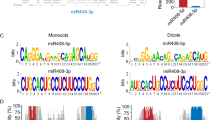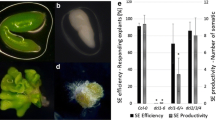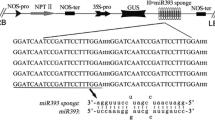Abstract
miR393, which is encoded by MIR393a and MIR393b in Arabidopsis, post-transcriptionally regulates mRNAs for the F-box auxin receptors TIR1 (Transport Inhibitor Response Protein 1), AFB1 (Auxin Signaling F-box Protein 1), AFB2 and AFB3. However, biological functions of the miR393-TIR1/AFBs module in auxin response and plant development is not fully understood. In the study herein, we demonstrate that miR393 accumulated in response to exogenous IAA treatment, and its induction was due to enhanced MIR393b transcription but not MIR393a. Overexpression of a miR393-resistant form of TIR1 (mTIR1) enhanced auxin sensitivity and led to pleiotropic effects on plant development including inhibition of primary root growth, overproduction of lateral roots, altered leave phenotype and delayed flowering. Furthermore, miR393 level was increased in 35S:mTIR1 plant, suggesting that TIR1 promoted the expression of miR393 by a feedback loop. The interaction between miR393 and its target indicates a fine adjustment to the roles of the miR393-TIR1 module, which is required for auxin responses in plant development.








Similar content being viewed by others
References
Allen E, Xie Z, Gustafson AM, Carrington JC (2005) microRNA-directed phasing during trans-acting siRNA biogenesis in plants. Cell 121(2):207–221
Bartel DP (2004) MicroRNAs: genomics, biogenesis, mechanism, and function. Cell 116(2):281–297
Bartel B, Bartel DP (2003) MicroRNAs: at the root of plant development? Plant Physiol 132(2):709–717
Carrington JC, Ambros V (2003) Role of microRNAs in plant and animal development. Science 301(5631):336–338
Clough SJ, Bent AF (1998) Floral dip: a simplified method for Agrobacterium-mediated transformation of Arabidopsis thaliana. Plant J 16(6):735–743
Dharmasiri N, Dharmasiri S, Estelle M (2005a) The F-box protein TIR1 is an auxin receptor. Nature 435(7041):441–445
Dharmasiri N, Dharmasiri S, Weijers D, Lechner E, Yamada M, Hobbie L, Ehrismann JS, Jurgens G, Estelle M (2005b) Plant development is regulated by a family of auxin receptor F box proteins. Dev Cell 9(1):109–119
Gou JY, Felippes FF, Liu CJ, Weigel D, Wang JW (2011) Negative regulation of anthocyanin biosynthesis in Arabidopsis by a miR156-targeted SPL transcription factor. Plant Cell 23(4):1512–1522
Guo HS, Xie Q, Fei JF, Chua NH (2005) MicroRNA directs mRNA cleavage of the transcription factor NAC1 to downregulate auxin signals for Arabidopsis lateral root development. Plant Cell 17(5):1376–1386
Hagen G, Guilfoyle T (2002) Auxin-responsive gene expression: genes, promoters and regulatory factors. Plant Mol Biol 49(3–4):373–385
Jones-Rhoades MW, Bartel DP (2004) Computational identification of plant microRNAs and their targets, including a stress-induced miRNA. Mol Cell 14(6):787–799
Jones-Rhoades MW, Bartel DP, Bartel B (2006) MicroRNAS and their regulatory roles in plants. Annu Rev Plant Biol 57:19–53
Kasschau KD, Xie Z, Allen E, Llave C, Chapman EJ, Krizan KA, Carrington JC (2003) P1/HC-Pro, a viral suppressor of RNA silencing, interferes with Arabidopsis development and miRNA function. Dev Cell 4(2):205–217
Kepinski S, Leyser O (2005) The Arabidopsis F-box protein TIR1 is an auxin receptor. Nature 435(7041):446–451
Kim J, Inoue K, Ishii J, Vanti WB, Voronov SV, Murchison E, Hannon G, Abeliovich A (2007) A microRNA feedback circuit in midbrain dopamine neurons. Science 317(5842):1220–1224
Li WX, Oono Y, Zhu J, He XJ, Wu JM, Iida K, Lu XY, Cui X, Jin H, Zhu JK (2008) The Arabidopsis NFYA5 transcription factor is regulated transcriptionally and posttranscriptionally to promote drought resistance. Plant Cell 20(8):2238–2251
Llave C (2004) MicroRNAs: more than a role in plant development? Mol Plant Pathol 5(4):361–366
Mallory AC, Vaucheret H (2004) MicroRNAs: something important between the genes. Curr Opin Plant Biol 7(2):120–125
Mallory AC, Bartel DP, Bartel B (2005) MicroRNA-directed regulation of Arabidopsis AUXIN RESPONSE FACTOR17 is essential for proper development and modulates expression of early auxin response genes. Plant Cell 17(5):1360–1375
Marin E, Jouannet V, Herz A, Lokerse AS, Weijers D, Vaucheret H, Nussaume L, Crespi MD, Maizel A (2010) miR390, Arabidopsis TAS3 tasiRNAs, and their AUXIN RESPONSE FACTOR targets define an autoregulatory network quantitatively regulating lateral root growth. Plant Cell 22(4):1104–1117
Navarro L, Dunoyer P, Jay F, Arnold B, Dharmasiri N, Estelle M, Voinnet O, Jones JD (2006) A plant miRNA contributes to antibacterial resistance by repressing auxin signaling. Science 312(5772):436–439
Parry G, Calderon-Villalobos LI, Prigge M, Peret B, Dharmasiri S, Itoh H, Lechner E, Gray WM, Bennett M, Estelle M (2009) Complex regulation of the TIR1/AFB family of auxin receptors. Proc Natl Acad Sci USA 106(52):22540–22545
Rajagopalan R, Vaucheret H, Trejo J, Bartel DP (2006) A diverse and evolutionarily fluid set of microRNAs in Arabidopsis thaliana. Genes Dev 20(24):3407–3425
Rhoades MW, Reinhart BJ, Lim L, Burge CB, Bartel B, Bartel DP (2002) Prediction of plant microRNA targets. Cell 110(4):513–520
Ruegger M, Dewey E, Gray WM, Hobbie L, Turner J, Estelle M (1998) The TIR1 protein of Arabidopsis functions in auxin response and is related to human SKP2 and yeast Grr1p. Genes Dev 12(2):198–207
She W, Lin W, Zhu Y, Chen Y, Jin W, Yang Y, Han N, Bian H, Zhu M, Wang J (2010) The gypsy insulator of Drosophila melanogaster together with its binding protein Su(Hw) (Suppressor of Hairy-wing) facilitate high and precise expression of transgenes in Arabidopsis thaliana. Genetics 185(4):1141–1150
Sieber P, Wellmer F, Gheyselinck J, Riechmann JL, Meyerowitz EM (2007) Redundancy and specialization among plant microRNAs: role of the MIR164 family in developmental robustness. Development 134(6):1051–1060
Sunkar R, Zhu JK (2004) Novel and stress-regulated microRNAs and other small RNAs from Arabidopsis. Plant Cell 16(8):2001–2019
Todesco M, Rubio-Somoza I, Paz-Ares J, Weigel D (2010) A collection of target mimics for comprehensive analysis of microRNA function in Arabidopsis thaliana. PLoS Genet 6(7):e1001031
Vanneste S, Friml J (2009) Auxin: a trigger for change in plant development. Cell 136(6):1005–1016
Varghese J, Cohen SM (2007) microRNA miR-14 acts to modulate a positive autoregulatory loop controlling steroid hormone signaling in Drosophila. Genes Dev 21(18):2277–2282
Vidal EA, Araus V, Lu C, Parry G, Green PJ, Coruzzi GM, Gutierrez RA (2010) Nitrate-responsive miR393/AFB3 regulatory module controls root system architecture in Arabidopsis thaliana. Proc Natl Acad Sci USA 107(9):4477–4482
Wang JW, Wang LJ, Mao YB, Cai WJ, Xue HW, Chen XY (2005) Control of root cap formation by microRNA-targeted auxin response factors in Arabidopsis. Plant Cell 17(8):2204–2216
Wang JW, Schwab R, Czech B, Mica E, Weigel D (2008) Dual Effects of miR156-Targeted SPL genes and CYP78A5/KLUH on plastochron length and organ size in Arabidopsis thaliana. Plant Cell 20(5):1231–1243
Wang J, Czech B, Weigel D (2009) miR156-regulated SPL transcription factors define an endogenous flowering pathway in Arabidopsis thaliana. Cell 138(4):738–749
Wu G, Park MY, Conway SR, Wang JW, Weigel D, Poethig RS (2009) The sequential action of miR156 and miR172 regulates developmental timing in Arabidopsis. Cell 138(4):750–759
Yoon EK, Yang JH, Lim J, Kim SH, Kim SK, Lee WS (2010) Auxin regulation of the microRNA390-dependent transacting small interfering RNA pathway in Arabidopsis lateral root development. Nucleic Acids Res 38(4):1382–1391
Acknowledgments
We sincerely thank Dr. Mark Estelle (Section of Cell and Developmental Biology, UCSD) for kindly providing the tir1-1 and tir1-1 afb1-1 afb2-1 afb3-1 quadruple mutants and Dr. C-Y Huang (The University of Adelaide, Australia) for helpful discussions and critical reading the manuscript. This work was supported by the National Science Foundation of China (Grant No. 30571197, No. 30972016), National High Technology Research and Development Program of China (863 Program) (No. 2007AA10Z141) and Zhejiang Provincial Natural Science Foundation of China (Grant No. Y3080323).
Author information
Authors and Affiliations
Corresponding authors
Electronic supplementary material
Below is the link to the electronic supplementary material.
11103_2011_9838_MOESM1_ESM.tif
Supplementary material 1 (TIFF 1991 kb). Supplemental Figure 1. Determination of endogenous TIR1 in wild-type, 35S:mTIR1 and 35S:TIR1 transgenic lines. Endogenous and miR393-resistant TIR1 (mTIR1) transcripts were amplified by RT-PCR and distinguished by digestion with the restriction enzyme NsbI, which cuts only mTIR1
11103_2011_9838_MOESM2_ESM.tif
Supplementary material 2 (TIFF 3279 kb). Supplemental Figure 2. Rosette leaves of 4-week-old 35S:MIR393 plants. a The first leaf with serrate margins was slightly delayed in 35S:MIR393 plants. Leaves from 4-week-old wild-type, 35S:MIR393a and 35S:MIR393b transgenic plants were cut and arranged in the order of appearance. Scale bar = 1 cm. b Rosette leaves of 4-week-old 35S:MIR393 plants displayed no remarkable differences in size or numbers. Wild-type, 35S:MIR393a and 35S:MIR393b transgenic plants grown under short-day conditions were photographed with side view (left) and top view (right)
11103_2011_9838_MOESM3_ESM.tif
Supplementary material 3 (TIFF 2053 kb). Supplemental Figure 3. Relative expression levels of TIR1 in Col-0 and tir1-1 plants. TIR1 level in tir1-1 plants was not significantly different from the level in wild-type. Relative transcript levels were normalized using UBQ5 as a standard. The relative expression levels in wild-type plants were set to 1.0. Error bars represent SD from three PCR results, and similar results were obtained in three independent experiments
11103_2011_9838_MOESM4_ESM.tif
Supplementary material 4 (TIFF 3373 kb). Supplemental Figure 4. pTIR1:mTIR1-tir1-1 plants display pleiotropic effects similar to 35S:mTIR1. a 5-day-old pTIR1:mTIR1-tir1-1 transgenic plants displayed downward cotyledons and upward petioles. b 10-day-old pTIR1:mTIR1-tir1-1 plants displayed downward curly true leaves with long and twisted petioles. c–d The narrow and bended rosette leaves from 4-week-old pTIR1:mTIR1-tir1-1 were much smaller in size and fewer in numbers. Transgenic plants grown under short-day conditions were photographed with side view (c) and top view (d)
Rights and permissions
About this article
Cite this article
Chen, ZH., Bao, ML., Sun, YZ. et al. Regulation of auxin response by miR393-targeted transport inhibitor response protein 1 is involved in normal development in Arabidopsis . Plant Mol Biol 77, 619–629 (2011). https://doi.org/10.1007/s11103-011-9838-1
Received:
Accepted:
Published:
Issue Date:
DOI: https://doi.org/10.1007/s11103-011-9838-1




